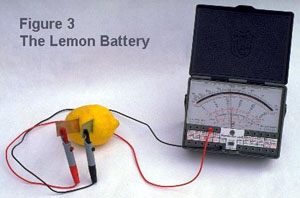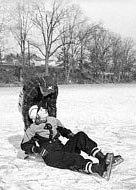 |
 | ||||||||||||
|
|||||||||||||

Insects
After having spent a number of weeks on subjects of astronomy, geology and the like, one of the girls arked me to talk about insects. Good! A change of scale.
First, in keeping with my aim to have them become familiar with the 'big
picture', I put insects on a scale of the history of the whole universe:
We did the
'why can ants carry 20 times their own weight?' demo.
This explains why many things about insects are so different from larger
animals. It is simply because they are so small.
Here are some bug links to explore:
|
|||||||||||||

How do batteries work?
The short answer is that any acid, plus two different metals makes a battery. For acids I brought in a lemon, a potato, an apple, and some vinager. Different metals to be found around the house are steel nails (iron), galvanized nails (zinc), aluminum foil, copper wire etc. With a voltmeter you can show the voltage of various combinations.
Links:
|
|||||||||||||

Why is ice slippery?
This is an interesting question because a few years ago I would probably have given the wrong answer. The old story was that the pressure of your skate would be enough to cause the ice under the blade to melt, or friction would melt the ice under your skate or ski. Wrong! Recent research (1999) has shown that there is a thin film of liquid on the surface of the ice, even at temperatures far, far below freezing. This is true for ice, but also for other materials. So ice is slippery because of this layer of water which is always there, regardless of pressure or friction. While we were talking about ice, someone asked:
Why do ice cubes make these noises when you
drop them in your glass?
This has to do with the fact that the water in the glass is warmer than the
ice cube. The cube gets warmed by the water, first the outside layer. The
warmer ice wants to expand, while the inside is still small and stays the
same. Cracks form inside the cube where the expanding ice breaks loose from
the inside part. That is what you hear, and you can see it too if you look
closely.
Links:
|
|||||||||||||

How do pendulums work?
We started by talking about how you could keep time in the age before clocks. The kids knew most of them: sundials, hourglasses with sand, water clocks (slow-dripping water basins), candles. For short time measurements, Galileo used to count his own pulse. In 1656, Dutch scientist Christiaan Huygens, one of my most famous compatriots from that age, patented the pendulum clock. He also invented the microscope, and immediately discovered microscopic life, improved the telescope and did many other great things - a busy man. In my tradition of doing demos with cardboard and duct tape, I made a working weight-driven pendulum and escapement. First I suspended the pendulum without the wheel or the escapement. The pendulum consisted of a 4' dowel, suspended from a 3.5" decking screw with a paperclip loop at the top, and a water bottle at the bottom, holding about a liter of water (about 2 pounds), also suspended by a paperclip. First we timed how many swings would fit in a minute. Then I poured out half the water. With half the weight, will the pendulum swing faster, or slower, or the same? It came out the same, of course. Also, if I swing the pendulum higher, will more, less or the same number of swings fit in one minute? Same answer: a pendulum ticks at the same rate, independent of how heavy it is or how high it swings. What does make a difference, is to make it shorter or longer. This is easier shown with a piece of string.
Now I slipped the ratchet wheel onto a nail in the base, and slid the
escapement onto the pendulum stick.
It is made out of cardboard and two
toothpicks. Now you can run the pendulum by gently pushing on the wheel.
The kids figured out quickly how to power this arrangement: water power
was mentioned, as well as weights. On the back of the rarchet wheel I had
glued the bottom inch of a cardboard oatmeal can, and onto this I wound
some string. On the end of the string hangs a weight (small pair of pliers).
You wind this up by sliding down the escapement cross piece, wind up the
string, then slide the escapement back up.
When you start it running, it runs for about 5 minutes, till the weight
touches the ground. [The biggest problem with this kind of mechanism is
twisting of the pendulum rod and escapement piece. Note that I glued two
strips of cardboard to the top of the stick, that make a fork that grabs
the back of the big screw. This prevents the stick from twisting. Lower
down I glued a double piece of cardboard to the stick, which serves as a
stop when you slide the escapement down and up during winding. It also
keeps the escapement from twisting.
Look here ]
Links:
|
|||||||||||||
| |||||||||||||
